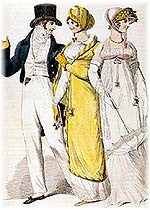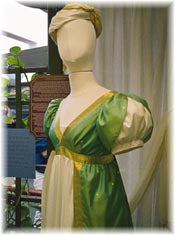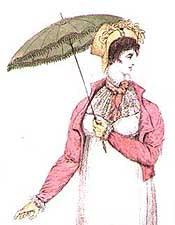A Tour of Regency Fashion: Day and Evening Dress
 The Regency Era (often given as 1812-1830, though the dates are flexible) officially began when the Prince of Wales became Regent of England after his father, George III, was declared insane.
The Regency Era (often given as 1812-1830, though the dates are flexible) officially began when the Prince of Wales became Regent of England after his father, George III, was declared insane.
This period was dramatically different from what came before it, Georgian decadence and excess, and from what followed, Victorian morality. The fashions, of course, reflected this change. In the eighteenth century fashions were highly elaborate, made of heavy brocades and satins with copious lace trim and quilted, beaded underskirts supported by a complicated infrastructure of hoops and panniers.
The entire confection would be crowned with elaborate wigs, tall feathers, and huge hats. By the 1790’s, a radical change was in the air. The change was precipitated by the French Revolution and its "democratic" tenets. Noblewomen and their maids alike dressed in the new style as silks gave way to light muslins, clinging lines, high waistlines, and arm-baring sleeves. These new styles were classically influenced, modeled on the ideals of the Greek and Roman worlds that were aped by the Revolution.
Throughout the Regency, there were certain elements of fashion that remained fairly consistent. Necklines were low and wide, filled in for daytime with fichus, scarves, or chemisettes; a high waistline; a fitted bodice, and fitted sleeves, either short and puffed, elbow-length, or long. There were trends; waistlines went up and down, more elaborate trims came into vogue, especially at the hems and necklines of gowns, and medieval and Renaissance details became popular, especially in England. As always, the French tended to be more daring in their fashions!
Day Dress
In the early Regency (approximately 1797-1805), the most common style of dress for day wear was one that was very classic in feel and simple in style-- what we often think of toady as "typical Regency". It was high-waisted with a wide neckline and rather long sleeves. Chemisettes (a style much like a modern dickey!) or fichus, often made of filmy fabrics, were used to fill in the neckline. Often there were no back fastenings; ![The two photos [I sent] were of the same dress, dressed up for evening and down for day. I made it from the La Mode Bagatelle Regency pattern (which can be bought at the Sense and Sensibility website). It's kind of expensive, about $48, but you can make about 10 different dress styles from it, as well as a pelisse and spencer. Very authentic, too, but a bit hard to sew.](https://cdn.shopify.com/s/files/1/0308/7889/2172/t/13/assets/description_image_ammanda1.jpg?v=1595755935) a woman could simply pull the dress over her shoulders and tie up the drawstrings.
a woman could simply pull the dress over her shoulders and tie up the drawstrings.
The term "chemise dress" was very descriptive of these dresses. (pictured on right) Early Regency dresses, even day dresses, also had trains, though this trend faded around 1805. Also after 1805, the longer, tighter sleeves began to give way to the shorter, puffed style. The drawstring fastening was often augmented by a hook or button in the back, at the neckline.
Waistlines continued to fluctuate, and around 1807-08 new, smooth bodices, not gathered but fitted with darts, began to emerge.  Early styles of dress had skirts of classical simplicity with very little trim or embroidery. They were also quite narrow, with all the fullness gathered in the back with the train. In the 1810s, gowns started becoming more elaborate.
Early styles of dress had skirts of classical simplicity with very little trim or embroidery. They were also quite narrow, with all the fullness gathered in the back with the train. In the 1810s, gowns started becoming more elaborate.
Tucks and flowers adorned hemlines. The English were especially fond of "Renaissance" details - ruffs, slashed sleeves, and lace (See the fashion plate on the left.). Heavier fabrics were needed to support these details, and silks and satins returned to vogue. By 1816, waistlines were at their highest, though often just a small band of fabric, and hems were at their most elaborate.
Evening Dress
Early Regency evening dress retained some eighteenth century richness, with colored silks and metallic trims, but the style was Classical, with high waists, narrow silhouettes and close-fitting, longer sleeves. A train was de riguer, as it was for day dress.
On the whole, evening fashion tended to resemble day dress styles. When trains disappeared for day dress, they became optional for evening. Waistlines raised and lowered; fabrics became simpler, then returned to more elaborate silks, satins, and velvets. Sleeves grew and became more gathered and puffed.
By 1815, the original classical simplicity of dress had all but vanished. Layered gowns (underdresses of silk or satin, often colored, and overdresses of sheer lace or gauze) came into vogue.
Hems were very elaborate, with artificial flowers, beadwork, lace and netting used. Ornamentation on the sleeves echoed that of the hems. (See fashion plate on the right). By 1825, the waistline approached the natural state, skirts were growing wider, and the fashion style of the Regency was ending. Soon it would give way entirely to the elaborate hoops and corsets of the Victorian age, sending fashion back full circle. Buy dress patterns to make your own Regency gown at the Jane Austen Centre Online Giftshop!
Ammanda McCabe is an author of Regency Romances and speaker at an upcoming writer's conference where her subject will be Regency Fashion. Her first book, Scandal in Venice, will be released this month. Order it today from Barnes and Noble! Ammanda's gown was made with "the La Mode Bagatelle Regency pattern (which can be bought at the Sense and Sensibility website). It's kind of expensive, about $48, but you can make about 10 different dress styles from it, as well as a pelisse and spencer. Very authentic, too, but a bit hard to sew. I've also made a gown from Simplicity 9221. It's easier to make, and looks fine with a few easy changes (like no zipper)." Select Bibliography Arnold, Janet. Patterns of Fashion 1. Quite Specific Media Group, Ltd.: 1975. Asheford, Jane. The Art of Dress. Harry Abrams: 19



Leave a comment
This site is protected by hCaptcha and the hCaptcha Privacy Policy and Terms of Service apply.